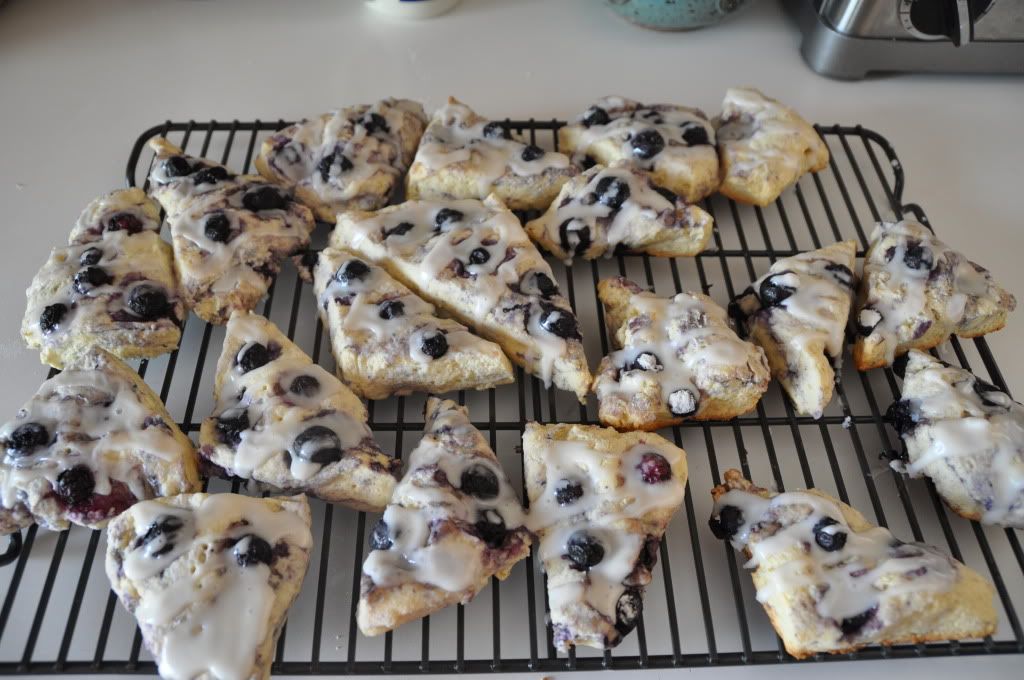
These scones were... oh my gosh. I can't even describe how tasty these were. And you're probably thinking, 'Woah girl. Chill. They're scones." And yeah, I know this. But seriously...melt in your mouth crumbles...totes noms.
But once again, I have to apologize for being a bad blogger, with the excuse that I wasn't actually planning on blogging when I made these. With that said: I have to inform you that I have no recipe to share with you. So really I shouldn't have hyped these up so much. However, now that I look back on it, I remember not being able to find a "to die for" recipe and I wanted to concoct The Perfect Scone. And I did so by combining elements of a few different recipes and kind of just going with the flow. All without writing down my modifications. Boo.
Since I've failed you, my dear readers, I will attempt to make it up by sharing a "best scone ever" recipe I've recently come across on the interwebz, but haven't tried yet. When I do finally make these, I'll be sure to share the results.
Here is the American Test Kitchen Cookbook's "Dreamy Cream Scones" recipe, which I found posted on one of my favorite blogs, Smitten Kitchen.
And here's the link to that blog if you want to check it out :)
http://smittenkitchen.com/
Dreamy Cream Scones
America’s Test Kitchen Cookbook
2 cups (10 ounces) unbleached all-purpose flour, preferably a low-protein brand such as Gold Medal or Pillsbury
1 tablespoon baking powder
3 tablespoons sugar
1/2 teaspoon salt
5 tablespoons chilled, unsalted butter, cut into 1/4-inch cubes
1/2 cup currants (I used dried cranberries, and chopped them into smaller bits)
1 cup heavy cream
1. Adjust oven rack to middle position and heat oven to 425°F.
2. Place flour, baking powder, sugar and salt in large bowl or work bowl of food processor fitted with steel blade. Whisk together or pulse six times.
3. If making by hand, use two knives, a pastry blender or your fingertips and quickly cut in butter until mixture resembles coarse meal, with a few slightly larger butter lumps. Stir in currants. If using food processor, remove cover and distribute butter evenly over dry ingredients. Cover and pulse 12 times, each pulse lasting 1 second. Add currants and pulse one more time. Transfer dough to large bowl.
4. Stir in heavy cream with a rubber spatula or fork until dough begins to form, about 30 seconds.
5. Transfer dough and all dry, floury bits to countertop and knead dough by hand just until it comes together into a rough, sticky ball, 5 to 10 seconds. Form scones by either a) pressing the dough into an 8-inch cake pan, then turning the dough out onto a lightly floured work surface, cutting the dough into 8 wedges with either a knife or bench scraper (the book’s suggestion) or b) patting the dough onto a lightly floured work surface into a 3/4-inch thick circle, cutting pieces with a biscuit cutter, and pressing remaining scraps back into another piece (what I did) and cutting until dough has been used up. (Be warned if you use this latter method, the scones that are made from the remaining scraps will be much lumpier and less pretty, but taste fine. As in, I understand why they suggested the first method.)
6. Place rounds or wedges on ungreased baking sheet and bake until scone tops are light brown, 12 to 15 minutes. Cool on wire rack for at least 10 minutes. Serve warm or at room temperature.

No comments:
Post a Comment